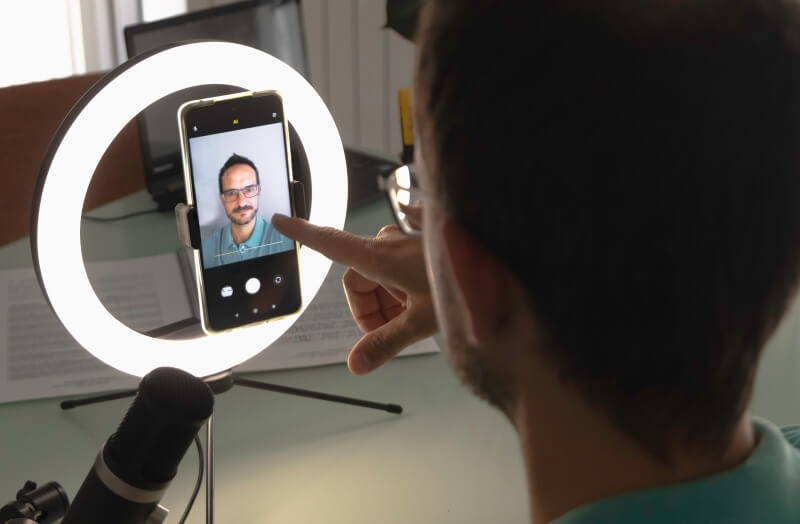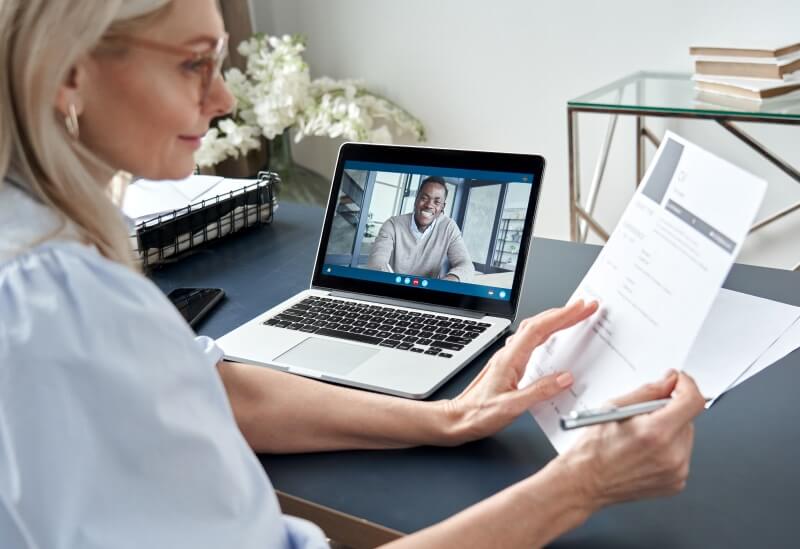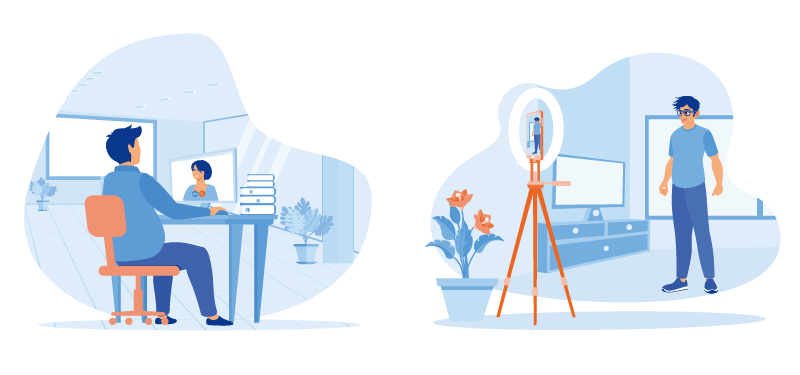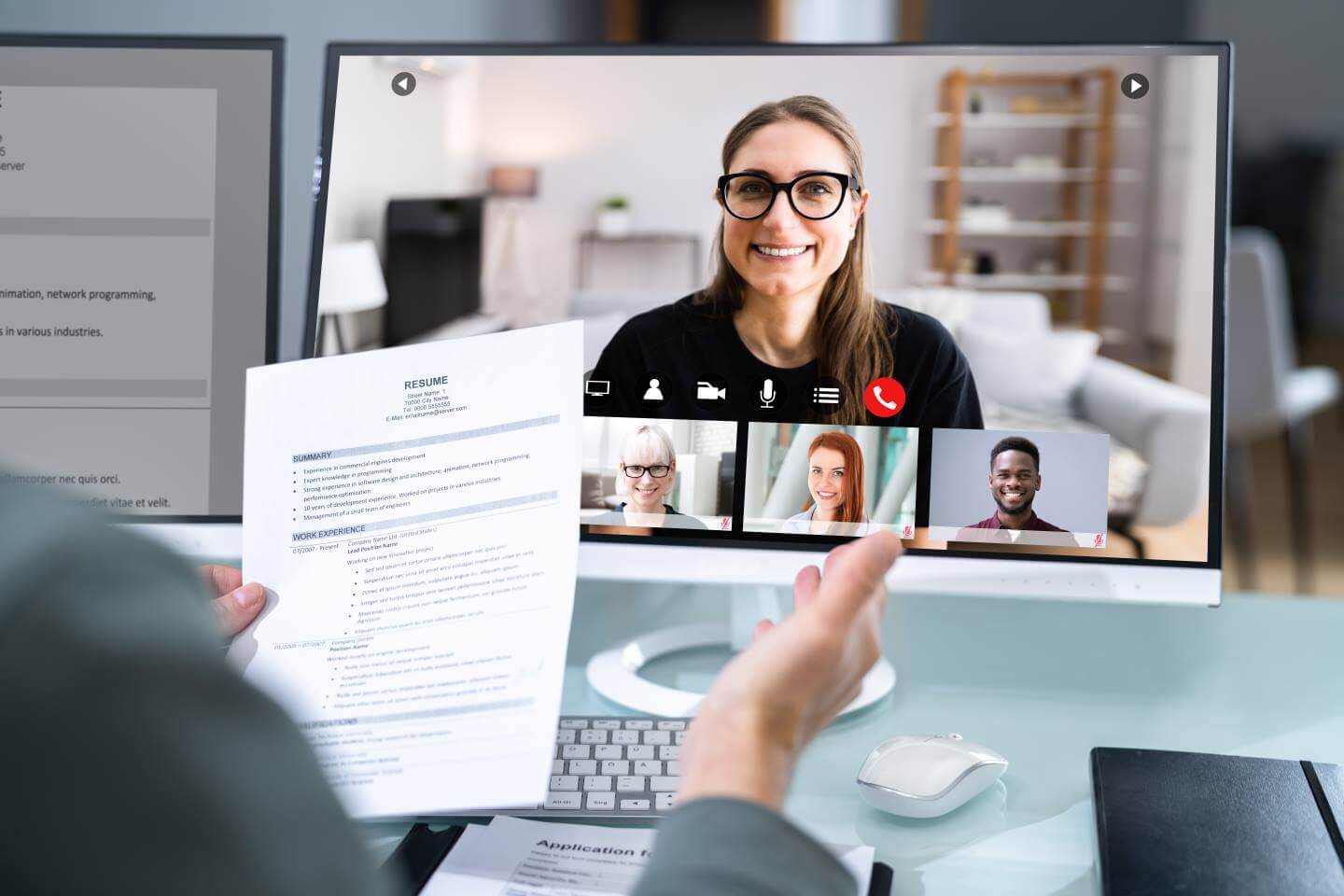Navigating video job interviews can be tricky. Here, we cut straight to the chase with actionable tips to bolster your video interview savvy. You’ll find clear strategies on technical setup, dressing aptly, making ‘eye contact’ through the lens, and articulating with confidence. Learn how to make a powerful impression from behind the screen, whether it’s a live session or a pre-recorded submission. Armed with the guidelines below, you’re set to conquer the challenge and move one step closer to your career goals.
Key Takeaways
- Adequate technical setup, professional attire, and a well-organized interview environment are foundational to a successful video interview outcome.
- Engaging authentically with the interviewer, maintaining good body language, confidently handling difficult questions, and being prepared for different kinds of video interviews are crucial to making a positive impression.
- Understanding and aligning with the company culture, leveraging technology effectively, and managing any potential interview disruptions professionally are key to video interview success.
Mastering the Set-Up for Your Video Interview

Imagine this: You’re in the middle of answering a critical job interview question, and suddenly, your screen freezes. The pixelated image of your interviewer stares back at you, and the audio cuts off. An unstable internet connection just added a negative to your job opportunity. Unthinkable, right? So, how can you ensure that this doesn’t happen in your next video interview? One way is to track outages and protect your internet connection to avoid such mishaps during the interview process.
A successful video interview not only hinges on answering the questions correctly but also on the overall experience you provide to your interviewer. So, you must pay attention to the technical aspects, including managing your privacy settings and ensuring a stable internet connection. This includes performing a thorough technical check-up before the interview begins.
The environment you choose for your interview and how you present yourself visually also play a vital role. You wouldn’t want your interviewer to be distracted by the clutter in your background or be put off by your casual attire. Choose the right environment and dress professionally to portray your very best.
Choosing the Right Environment
Your chosen environment for the video interview can reflect significantly on you, depending on your settings. It’s not just about finding a quiet place; it’s about ensuring that this location helps you put your best foot forward. You need to make sure you’re well-lit, avoiding glare and reflections on your screen or glasses. A well-balanced three-point lighting setup can help you achieve a natural and professional appearance on camera.
A professional appearance also extends to your background. An uncluttered, neutral background prevents giving unexpected insights into your private space and helps in making a good impression. And, of course, try to prevent pets or household members from inadvertently disturbing the interview by securing them away from the interview space, ideally not in the same room.
Technical Check-Up Before You Begin
A lost Internet connection might not directly cost you the job, but it could negatively affect your candidacy. Your interviewer may wonder if the lost connection is a one-off or a recurring issue. She may be wondering, “Would this candidate reliably host and attend virtual meetings in this job or will they be dealing with connection issues for our clients?” This is especially a concern if the job is virtual and a stable internet connection is a requirement for the position.
Here are some tips to help you prevent issues during your virtual interview:
- Familiarize yourself with the interview software well in advance, install it, update it to the latest version, and practice features like screen sharing.
- Prior to the interview, test your camera and microphone for functionality.
- Ensure your internet connectivity is stable.
- Use headphones if necessary for sound quality.
If you encounter issues, troubleshoot by using the latest browser version, closing unnecessary programs, and practicing muting and unmuting your microphone.
By following these steps in your job search, you’ll be well-prepared for your next interview and on the right career path.
Dressing for the Camera
Next, we turn our attention to your on-camera appearance. How you dress for a video interview is as important as an in-person interview. Avoiding distracting patterns in clothing can prevent unwanted camera effects and maintain a professional appearance on video.
And remember, dress professionally from top to bottom. You never know when you might need to stand up during the interview. Subtle jewelry can enhance your appearance on camera, but ensure it does not distract from your face.
The Dynamics of Digital Interviewing Skills

Similar to face-to-face job interviews, your demeanor during a video interview can largely shape the interviewer’s perception of you. This goes beyond simply answering the interview questions correctly. It’s about confidently conveying your thoughts, engaging with the interviewer, and handling difficult questions with grace and poise.
Eye contact is a critical element in establishing a connection with the interviewer. However, maintaining eye contact in a video interview is different from how you would do it in an in-person interview. You need to position the interviewer’s video window close to the camera and occasionally glance at the camera to simulate direct eye contact. Practicing this skill with a friend or a career coach and reviewing the recordings can be extremely beneficial.
Further, your approach to handling challenging questions can significantly sway the interviewer’s opinion about you. Taking a moment to pause and think before answering and asking for clarification when needed shows a thoughtful approach to difficult questions. Using the STAR method to answer behavioral questions helps organize responses in a clear, logical fashion, touching upon:
- the situation
- the task
- the action taken
- the result achieved.
Finally, try to portray yourself as naturally as possible. Virtual interviews make it easier to prepare notes ahead of time. This may seem like a positive but it can also come across as being overly scripted if you read your notes verbatim. Grab your friend or career coach noted above to help you do a virtual “screen test” to see if you can make eye contact while referring to your notes at the same time.
Conveying Confidence Digitally
In the context of video interviews, portraying confidence extends beyond your spoken answers. Your body language and demeanor play a significant role in projecting confidence. Here are some tips to help you appear confident:
- Maintain eye contact with the camera
- Sit upright
- Remain still
- Use hand gestures moderately to emphasize points
- Smile to appear approachable
Speak clearly and at a reasonable pace, ensuring your tone and pitch are natural to display enthusiasm and engagement. Wearing clothes that make you feel confident can positively impact your performance. Remember, your comfort is key, so dress in a manner that is comfortable for sitting to avoid distractions during the interview.
Engaging with Your Interviewer
Establishing a connection with your interviewer is pivotal in all job interviews, including virtual interviews. Start by engaging in small talk and using a ‘digital handshake’ looking into the camera and smiling. Show active listening by nodding, providing verbal affirmations, and waiting for the interviewer to finish speaking before responding.
Weave in relevant personal anecdotes that relate to the conversation topics to make your interview memorable. Demonstrate your interest and encourage a meaningful dialogue by asking questions about the role, company, or the interviewer’s experiences. This will make your conversation interactive and engaging.
Handling Difficult Questions with Poise
Addressing challenging questions gracefully can differentiate you from other candidates. Start by preparing for these questions by reflecting on possible challenges and rehearsing tailored answers. Using the STAR method to answer behavioral questions helps organize responses in a clear, logical fashion.
Remember, it’s okay to take a moment to pause and think before answering. It shows that you’re thoughtful and considerate. And if needed, ask for clarification. But remember, conciseness in answers is crucial to maintaining the interviewer’s attention and conveying messages effectively without becoming long-winded.
Navigating Different Types of Video Interviews

Video interviews, much like in-person job interviews, also come in various formats. Recognizing these formats and adapting your strategies accordingly can set the stage for a successful interview. Video interviews typically come in two main formats: live and pre-recorded. Live virtual interviews require responding to questions in real-time, simulating an in-person interview experience. Pre-recorded video interviews, on the other hand, allow candidates to answer preset questions at a time that suits them, without the presence of an interviewer. Regardless of the format, situational questions, such as role-playing responses to hypothetical work scenarios, may be included.
In a live video interview, using visual cues, clear communication, and mirroring the interviewer’s energy can create a subtle connection, making the interview feel natural and genuine. In a pre-recorded interview, on the other hand, you must approach the session with professionalism, practice answers, and anticipate relevant questions. Despite the differences, the goal remains the same: to present yourself as the best candidate for the role in the same way.
Strategies for Live Virtual Interviews
During a live virtual interview, employing visual cues such as nodding and facial expressions is vital to demonstrate engagement. Verbally affirm key points the interviewer is making to demonstrate that you’re actively engaged and processing the information. Allow brief pauses after the interviewer asks a question to show that you are considering your answer rather than giving a pre-scripted response. Prepare intelligent questions to ask during the interview, signaling your interest and that you’ve done your homework about the company or role. This approach not only helps in the interview process but also contributes to audience engagement and site interaction.
Mirror the interviewer’s energy and tone to create a subtle connection. And remember, clear and concise communication is key during live virtual interviews to prevent misunderstandings due to potential audio and video lag. Maintain strong posture and use hand gestures to a minimum to convey confidence without becoming a distraction.
Excelling in Pre-Recorded Interview Scenarios
Pre-recorded job interviews offer the chance to respond to predetermined questions at your own speed, but remember, some platforms may limit you to a single attempt. Therefore, it’s crucial to approach the pre-recorded interview with the same level of professionalism as an in-person interview. Ensure you’re calm, confident, and ready to tackle the interview.
Anticipate and prepare for questions that delve into your qualifications and your enthusiasm for the role and the company. Practice your answers to maintain a confident tone, yet strive to keep them sounding natural rather than overly scripted. In doing so, you’ll be applying valuable career advice to ace your interview.
Common Video Interview Questions Decoded

Next, we address another vital component of virtual interviews: interpreting common interview questions. Many candidates enter an interview prepared for the usual questions, but what sets you apart is how you tailor your answers to showcase your personal story, interest in the role, and unique qualifications.
Closed-ended interview questions typically require a straightforward ‘yes’ or ‘no’ answer, while open-ended questions allow for detailed answers. These open-ended questions provide an opportunity for you to share relevant experiences and insights. Using bullet points as a reference during the interview can help you recall and communicate key points without appearing to read from a script, allowing for a more natural delivery.
But, the key is not merely to answer the questions. In virtual interviews, it’s essential to demonstrate confidence, professionalism, and enthusiasm. These are key qualities that interviewers assess through candidates’ responses and demeanor. Therefore, crafting your personal story, expressing your interest in the role, and showcasing your unique qualifications are essential aspects of decoding and effectively responding to common virtual interview questions.
Crafting Your Personal Story
While answering ‘Tell me about yourself,’ ensure a balanced mix of professional and personal information. This balance could be approximately 80% professional and 20% personal. In the professional segment of your personal story, include:
- Your skills
- Work experiences
- Education
- Any relevant extracurricular or volunteer activities
Tailor your personal story to directly connect to the role and company you’re applying for, demonstrating clear relevance and fit, while considering age appropriate if relevant factors. Make sure your homepage and tailored ads reflect this connection to maximize your chances of success.
Highlighting your passion for your work and the company can make your personal story more engaging and memorable to the interviewer.
Expressing Your Interest in the Role
Demonstrating authentic interest in the role can distinguish you from other candidates. To do this, you can:
- Demonstrate enthusiasm for the company’s mission, vision, or products
- Share specific instances where your skills and past achievements align with the requirements of the job to articulate your suitability
- Engage with the interviewer by asking intelligent questions regarding the company’s future plans or current initiatives to show active interest.
Utilize knowledge from company press releases and blog posts to show awareness of their recent developments, and relate these to your own experience and aspirations.
Showcasing Your Unique Qualifications
Like every candidate, you too bring unique attributes and experiences to the table. Use the virtual interview opportunity to highlight your unique qualifications and experiences that make you a distinct fit for the position. Reflect on your personal and professional journey, identifying any uncommon skills or experiences that set you apart from other applicants.
Align your unique strengths directly with what the job requires, effectively communicating how these attributes can contribute to the company’s objectives.
Leveraging Technology to Enhance Your Interview

In this digital era, technology transcends being merely a tool; it can revolutionize your interview process. From optimizing your equipment to leveraging online resources, technology can significantly enhance your video interview experience. But how exactly can you harness this power to your advantage?
Digital notepads, for instance, can assist job seekers during video job interviews by allowing them to discreetly refer to their prep notes without breaking eye contact with the camera. Applications like Transparent Note—available for both Mac and Windows—enables candidates to place transparent notes over their video conferencing interface, ensuring they have key points accessible while maintaining a professional appearance during the interview. These tools, combined with a reliable device, a good webcam, and microphone, can ensure a smooth interview experience.
Videos you can watch of other people doing job interviews can provide technical tips to help you develop and improve your own. There are hundreds you can search for on YouTube. Observe any technical tools in use, listen for the quality of those services, and how well the videos you watch deliver the right message that would make a company hire those job seekers.
Optimizing Your Equipment
Selecting the appropriate equipment can significantly influence your video interview experience. Here are some pre-interview tips to consider:
- Choose a laptop or desktop that has enough RAM to enhance the quality of the experience rather than bogging it down.
- Ensure you maintain a stable internet connection with enough bandwidth for your virtual interview to minimize technical issues.
- Improve your interview’s audio quality by using an external microphone if needed.
- Conduct a test call to check all audio and video settings before the interview. Depending on your settings, you can develop and improve new features that enhance the job interview.
Other technological interview tips include using noise-canceling headphones to ensure clear communication during the virtual interview. You might be able to borrow some if yours are not of sufficient quality.
Practice recording yourself using video platforms like Zoom or Teams to become comfortable with your on-screen presence. Maintain Google services too. Your potential employer might strictly deliver and maintain Google services so you’ll want to be ready and show your savvy.
Lastly, use a reputable username on video interview platforms to set a professional tone from the start of the interview.
Consider Using a Tripod

If you only have a mobile phone, using a tripod for a virtual job interview can help you maintain a stable and professional-looking camera angle. Here are some tips for using a tripod effectively:
Choose the right tripod: Select a tripod that is sturdy and tall enough to position your camera at eye level. This helps create a more natural and engaging video presence.
Set up your camera: Mount your camera securely on the tripod and position it at eye level. Ensure that the camera is stable and not wobbly.
Frame your shot: Position the camera so that your head and shoulders are centered in the frame. Make sure there is enough space above your head and that your entire face is visible.
Adjust the tripod height: Use the tripod’s adjustable legs to set the camera at the right height. Avoid tilting the camera up or down too much, as this can create unflattering angles.
Check the lighting: Position yourself facing a natural light source, such as a window, to ensure even and flattering lighting. Avoid strong backlighting, as it can create a silhouette effect.
Test the camera angle: Before the interview, test the camera angle to ensure that you are comfortable and that the background is not distracting.
Use a remote shutter: If possible, use a remote shutter or timer to take photos or start video recording without having to touch the camera, which can cause shaking.
Practice with the setup: Spend some time practicing with the tripod and camera setup to become comfortable with adjusting the height and angle as needed.
A tripod used for your virtual job interview can make a major difference how you come across to the job interviewer. You will present yourself professionally and stably, helping to make a positive impression.
Overcoming Common Virtual Interview Challenges
Despite thorough preparation, virtual job interviews may present unique challenges. From dealing with technical difficulties to maintaining focus amid distractions, there’s a lot that could disrupt your flow. But with adequate preparation and the right strategies, you can overcome these challenges with ease.
Dealing with technical difficulties promptly, having alternative contact methods available, and communicating any non-technical pauses during the interview can all contribute to a smooth interview experience. Similarly, minimizing potential interruptions, informing others not to disturb, and acknowledging any unexpected distractions professionally can help maintain focus during the interview.
Dealing with Technical Difficulties
Handling technical issues during a virtual interview can be quite stressful. But remember, the way you handle these issues can also reflect your problem-solving skills. If technical difficulties occur during the interview, promptly inform the interviewer and consider restarting any disrupted systems if necessary. Have alternative contact methods, like email or phone, readily available to quickly communicate with the interviewer.
During the interview, remember to:
- Clearly communicate any non-technical pauses, like note-taking or thinking
- Report any technical glitches like poor audio or video quality to the interviewer
- If these issues persist, it may be appropriate to apologize to the interviewer and express continued interest in the position, asking for a second chance if necessary.
Maintaining Focus Amid Distractions
An unexpected interruption is the least desirable event during a video interview. But life happens, right? The trick is to minimize potential interruptions before they happen. Prepare your location space by choosing a quiet, private area and arranging it to be free from distractions. Inform housemates or family not to disturb you during the job interview time, a key step to prevent being interrupted.
Despite all precautions, if an interruption does occur, own it by acknowledging and apologizing at the start. This minimizes the disruption and can show your professionalism. And remember, dress professionally for the interview, as appropriate attire contributes to a focused and confident mindset.
Tailoring Your Approach to the Company Culture
Grasping the company culture is a vital part of preparing for any job interview. But why is it so important? How you fit into a company’s culture could be a determining factor in your success at the organization. So, how can you tailor your approach to align with the company culture?
Initiate by examining the company’s mission, values, and distinguishing elements that set it apart from its competitors. Review the company’s website, specifically the ‘About Us’ section. Read the company’s corporate blogs and LinkedIn updates to become informed on recent developments and their publicized news or achievements. Look at online reviews and profiles on platforms such as The Muse and Glassdoor to complement your understanding of the company’s culture and employee satisfaction.
Having collected this information, illustrate your alignment with the company’s values and culture by sharing relevant experiences and viewpoints during the interview.
Research the Company’s Values
Investigating a company’s values constitutes the initial move toward comprehending its culture. Here are some steps you can take:
- Review the company’s website, specifically the ‘About Us’ section, to understand its mission, values, and what makes it unique.
- Read the company’s corporate blogs and LinkedIn updates to get an idea about their recent developments and achievements.
- Use social media platforms like LinkedIn, Twitter, and Facebook to observe the company’s culture and engage with current company discourse.
Look at online reviews and profiles on platforms such as The Muse and Glassdoor to get an insight into the company’s culture and employee satisfaction. And if possible, reach out to current and former employees for personal insights.
Demonstrate a Good Fit Culturally
Having explored the company’s values, the next step is to display your compatibility. During the interview, mention your alignment with the company’s values. This shows genuine interest and fits with the organization’s culture. Discuss your knowledge of why the company maintains high employee retention or has a unique workplace. This shows your commitment to the company’s vision. Avoid sensitive topics such as past issues with work-life balance, unless they are a clearly stated positive aspect of the company. This can show respect for the company’s existing culture.
Be honest about your experiences with and perspective on company culture and how you feel you’re a good fit. This demonstrates authenticity and thoughtful engagement with the company’s values.
Summary
Congratulations! You’re now equipped with invaluable interview tips and strategies to master your next video interview. From setting up your equipment to decoding common interview questions, from navigating different types of video interviews to overcoming challenges, you’re ready to make a great impression. Remember, a successful video interview is not just about answering the questions right; it’s about the overall experience that job seekers provide to their interviewer. So, step into the digital interviewing world with confidence, authenticity, and preparation, and let your skills and personality shine through!
Frequently Asked Questions
How do you do a video interview?
To do a video interview, dress professionally, test your technology, and set up your space with good lighting and camera positioning. Practice making eye contact and pay attention to how you sound during the interview.
Are video interviews effective?
Yes, video interviews are effective as they help hiring managers efficiently compare candidates without delaying the hiring timeline or experiencing scheduling complications inherent with in-person interviews. This can reduce the risk of losing candidates to faster-moving companies.
What is a video interview?
A video interview is similar to a face-to-face interview, where you will be asked questions in real time by an interviewer or a panel of interviewers using platforms like Skype, Microsoft Teams, or Google Meet.
How can I ensure a stable internet connection during my video interview?
To ensure a stable connection to the internet during your video interview, check the speed of your connection. If it isn’t adequate, either increase he speed or see if you can use a friend’s high-speed connection. Other virutal interview tips include using an Ethernet cable connected directly to your modem or router and checking for potential bandwidth issues such as other household members streaming content. These should help maintain a reliable connection.
How can I maintain focus during a video interview?
To maintain focus during a video interview, ensure you’re in a quiet, distraction-free area and communicate with household members to avoid interruptions. This will help create a professional atmosphere for your interview.



